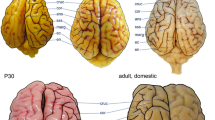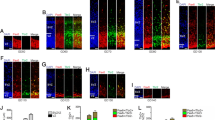Summary
The development of the neocortex of the marsupial Monodelphis domestica has been studied from birth until adulthood. Monodelphis is born after a gestational period of 14 days, a time when the neocortex is still at a two-layered “embryonic’ stage of development, that is equivalent to a 13–14 day rat embryo or 6 week human embryo. The cortical plate does not begin to appear until 3 to 5 days postnatal. Thus the whole of neocortical development is a postnatal phenomenon in this species, as has been previously described in other marsupials. The general pattern of development of the characteristic layers of the immature neocortex and the subsequent development of a six-layered adult neocortex is similar to that found in eutherian species. However there are some differences. The depth of the immature cortical plate when compared to the thickness of the neocortical wall is less than in eutherians and the subplate zone is much deeper in Monodelphis; this transient subplate zone consists of widely spaced rows of cells that are aligned parallel to the cortical surface. Unlike eutherians there appears to be no secondary proliferative zone in the subventricular zone of the dorso-lateral neocortical wall.
Maturation of the neocortex is apparent by 45 days postnatal and by 60 days (around the time of weaning) the characteristic six-layered adult neocortex is clearly present. The neuronal marker PGP 9.5 was used to define neuronal populations in the adult brain. The density of neurons in Monodelphis appears to be considerably less than in eutherians such as the rat. The suitability of postnatal Monodelphis for studies of neocortical development is discussed.
Similar content being viewed by others
References
Abbie AA (1939) The origin of the corpus callosum and the fate of structures related to it. J Comp Neurol 71:9–44
Angevine JB Jr, Sidman RL (1961) Autoradiographic study of cell migration during histogenesis of cerebral cortex in the mouse. Nature 192:766–768
Bennett JH, Smith MJ, Hope RM, Chesson CM (1982) Fat-tailed dunnart Sminthopsis crassicaudata: establishment and maintenance of a laboratory colony. In: Evans DD (ed) The Management of Australia Marsupials in Captivity. The Zoological Board of Victoria Melbourne, pp 38–44
Berry M, Rogers AW (1965) The migration of neuroblasts in the developing cerebral cortex. J Anat (Lond) 99:69–109
Boulder Committee (1970) Embryonic vertebrate central nervous system: revised terminology. Anat Rec 166:257–261
Cabana T, Martin GF (1984) Developmental sequence in the origin of descending spinal pathways. Studies using retrograde transport techniques in the North American opossum (Didelphis virginiana). Dev Brain Res 15:247–263
Cavanagh ME, Møllgård K (1985) An immunocytochemical study of the distribution of some plasma proteins within the developing forebrain of the pig, with special reference to the neocortex. Dev Brain Res 17:183–194
Cothran EG, Aivaliotis MJ, VandeBerg JL (1985) The effects of diet on growth and reproduction in Gray Short-tailed Opossums (Monodelphis domestica). J Exp Zool 236:103–114
Dziegielewska KM, Habgood MD, Jones SE, Reader M, Saunders NR (1989) Proteins in cerebrospinal fluid and plasma of postnatal Monodelphis domestica (Grey short-tailed opossum) Comp Biochem Physiol 92B:569–576
Fadem BH, Trupin GL, Maliniak E, Vandeberg, Hayssen V (1982) Care and breeding of the gray, short-tailed opossum (Monodelphis domestica). Lab Animal Sci 32:405–409
Fernandez V, Bravo H (1974) Autoradiographic study of development of the cerebral neocortex in the rabbit. Brain Behav Ecol 9:317–332
Gemmell RT (1982) Breeding bandicoots in Brisbane (Isoodon macrourus Marsupialia: Peramelidae). Aust Mammology 5:187–193
Godfrey GK, Crowcroft P (1971) Breeding the fat-tailed marsupial mouse Sminthopsis crassicaudata in captivity. Int Zoo Yearbook 11:33–38
Goffinet AM (1984) Events governing organization of postmigratory neurons: studies in brain development in normal and reeler mice. Brain Res Rev 7:261–296
Gray PA (1924) The cortical lamination pattern of the opossum Didelphis virginiana. J Comp Neurol 37:221–263
Johnson JL Jr (1977) In: Hunsaker D (ed) The biology of the marsupials. II. Acad Press, NY Ch 4, pp 159–264
Jurgelski W, Porter ME (1974) The opossum (Didelphis virginiana) as a biomedical model. III. Greeding the opossum in captivity: methods. Lab Animal Sci 24:412–425
King JS, Morgan JK, Bishop GA, Hazlett JC, Martin GF (1987) Development of the basilar pons in the North American opossum: dendrogenesis and maturation of afferent and efferent connections. Anat Embryol 176:191–202
Kraus DB, Fadem BH (1987) Reproduction, development and physiology of the Gray Short-tailed Opossum (Monodelphis domestica). Lab Animal Sci 37:478–482
Lende RA (1969) A comparative approach to the neocortex: localization in monotremes, marsupials and insectivores. Ann NY Acad Sci 196:262–276
Luskin MB, Schatz CJ (1985) Studies on the earliest generated cells of the cat visual cortex: cogeneration of subplate and marginal zones. J Neuroscience 5:1062–1075
McConnell SK (1988) Development and decision-making in the mammalian cerebral cortex. Brain Res Rev 13:1–23
McCrady E Jr (1938) The embryology of the opossum. The American Anatomical Memoirs 16:1–233, Wistar Institute, Philadelphia
Marin-Padilla M (1978) Dual origin of the mammalian neocortex and evolution of the cortical plate. Anat Embryol 152:109–126
Møllgård K, Jacobsen M (1984) Immunohistochemical identification of some plasma proteins in human embryonic and fetal forebrain with particular reference to the development of the neocortex. Dev Brain Res 13:49–63
Møllgård K, Reynolds ML, Jacobsen M, Dziegielewska KM, Saunders NR (1984) Differential immunocytochemical staining for fetuin and transferrin in the developing cortical plate. J Neurocytol 13:497–502
Morest DK (1970) A study of neurogenesis in the forebrain of the opossum pouch young. Z Anat Entwickl Gesch 130:265–305
Privat A, Leblond CP (1972) The subependymal layer and neigh-bouring region in the brain of the young rat. J Comp Neurol 146:277–305
Raedler E, Readler A (1978) Autoradiographic study of early neurogenesis in rat neocortex. Anat Embryol 154:267–284
Raedler E, Raedler A, Feldhaus S (1980) Dynamical aspects of neocortical histogenesis in the rat. Anat Embryol 158:253–269
Reynolds ML (1987) Early development of the neocortex in Eutheria and Metatheria. PhD Thesis, University of London, p 94
Reynolds MI, Møllgård K (1985) The distribution of plasma proteins in the neocortex and early allocortex of the developing sheep brain. Anat Embryol 171:41–60
Reynolds ML, Saunders NR (1988) Differentiation of the neocortex. In: Tyndale-Biscoe CH, Jassens PA (eds). The Developing Marsupial. Models for Biomedical Research. Springer-Verlag, Berlin Heidelberg New York, pp 101–116
Reynolds ML, Cavanagh ME, Dziegielewska KM, Hinds LA, Saunders NR, Tyndale-Biscoe CH (1985) Postnatal development of the telencephalon of the tammar wallaby (Macropus eugenii). An accessible model of neocortical differentiation. Anat Embryol 173:81–94
Rickmann M, Chronwall BM, Wolff JR (1977) On the development of non-pyramidal neurons and axons outside the cortical plate: the early marginal zone as a pallial anlage. Anat Embryol 151:285–305
Selwood L (1982) Brown antechinus Antechinus stuartii: management of breeding colonies to obtain embryonic material and pouch young. In: Evans DD (ed) The Management of Australian Mammals in Captivity. Zoological Board of Victoria, Melbourne, pp 31–37
Smart IHM (1961) The subependymal layer of the mouse brain and its cell production as shown by radioautography after thymidine-H3 injection. J Comp Neurol 116:325–347
Sternberger LA (1979) Immunocytochemistry, 2nd edn. John Wiley and Sons, New York, pp 89–92
Thompson RJ, Day INM (1988) Protein gene product 9.5: a new neuronal and neuroendocrine marker. In: Marangos PJ, Campbell IC, Cohen RM (eds) Neuronal and Glial Protein structure, Function and Clinical Application. Academic Press, NY, pp 209–228
Tyndale-Biscoe CH (1973) Life of marsupials. Arnold, London
Tyndale-Biscoe CH, Renfree M (1987) Reproductive physiology of marsupials. CUP, Cambridge
VandeBerg J (1983) The gray short-tailed opossum: a new laboratory animal. ILAR News XXVI (3):9–12
Author information
Authors and Affiliations
Rights and permissions
About this article
Cite this article
Saunders, N.R., Adam, E., Reader, M. et al. Monodelphis domestica (grey short-tailed opossum): an accessible model for studies of early neocortical development. Anat Embryol 180, 227–236 (1989). https://doi.org/10.1007/BF00315881
Accepted:
Issue Date:
DOI: https://doi.org/10.1007/BF00315881




